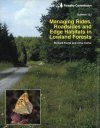Out of Print
By: Richard Ferris(Author), Clive Carter(Author)
86 pages, 8 plates with colour photos and colour illustrations; b/w photos, b/w illustrations, tables
![Managing Rides, Roadsides and Edge Habitats in Lowland Forests Managing Rides, Roadsides and Edge Habitats in Lowland Forests]()
Click to have a closer look
About this book
Related titles
About this book
Language: English with multilingual summary in English, French, German, and Welsh
Rides, roadsides and edges are important habitats in forests. Their priority in forest management for conservation is further emphasised by The UK forestry standard statement on the importance of "...maintenance, conservation and appropriate enhancement of biological diversity in forest ecosystems..." as a key criterion in sustainable forest management. Forest edge species are particularly important in British forests. This is largely because historical forest fragmentation and silvicultural regimes based on coppicing and wood pasture favoured edge species and maintained unnaturally high populations which, today, are of conservation importance. The same historical trends resulted in a decline in forest interior habitats and species which should not be overlooked in management planning. Edge habitats in plantations often form interlinked networks of roads, rides, watercourses, wayleaves, operational open space and stand boundaries which enhance their conservation value. They can serve as refugia for recolonisation of felled or thinned stands.
Forest edges have particular microclimatic conditions which are favourable to many species of conservation importance. These arise mainly from the availability of direct sunlight and shelter. They are generally subject to successional processes, leading to colonisation and establishment of woodland, although these are likely to be modified or arrested by herbivores. Manipulation of light, microclimate and vegetation succession are the basis for management of edges for several purposes: to create diverse and species rich edge habitats, to provide for the needs of particular species groups, or to maintain semi-natural open habitats.
A clear management strategy with specific targets is essential to focus management efforts. This will be influenced by judgements of what is feasible, ecologically appropriate, cost-effective, affordable and compatible with other management objectives, over the time scale required for the desired benefits to accrue. The process must begin with an objective assessment of management potential, both ecological, organisational and financial. Once the potential is established, a design and management approach can be formulated. This Bulletin provides information on the ecological value and management of rides, roadsides and edge habitats. Part One describes the ecology of edges and open areas. It looks at their value in both semi-natural and plantation woodland, and discusses the influences of light and microclimate, vegetation succession and wildlife. Part Two provides a guide to edge management options, including practical advice on strategy, design, maintenance of vegetation zones and monitoring.
Customer Reviews
Out of Print
By: Richard Ferris(Author), Clive Carter(Author)
86 pages, 8 plates with colour photos and colour illustrations; b/w photos, b/w illustrations, tables



































